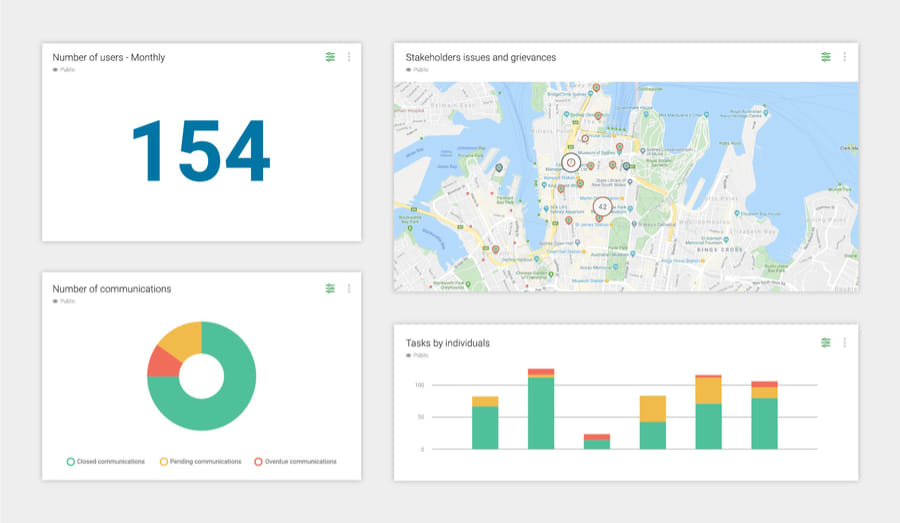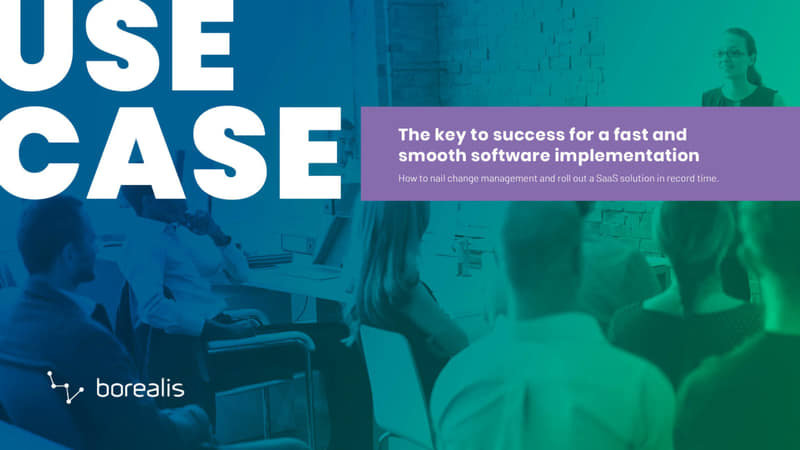USE CASE
The keys to success for a fast and smooth software implementation
How one of our customers nailed change management and rolled out a SaaS solution in record time.
The need
A global company based in Australia was looking to replace its underused stakeholder management system with a more powerful and flexible platform that would enable its social performance team to manage stakeholder plans and activities more efficiently.
Objectives
Implement a single platform that could be used by dozens of users working on multiple mining projects globally to easily plan, record, track, and report on all stakeholder engagement activities.
The solution
Borealis stakeholder management software – a fit-for-purpose SaaS solution for managing Community Engagement, Land Access And Management, Public Affairs & Government Relations, and Social & Environmental Performance
The challenge
The client wanted to complete this complex implementation quickly to comply with new internal performance standards, all while improving best practices. This would require lots of support from within the organization.
Here’s how the organization made this possible.
7 keys to success
1. A corporate culture open to change
Borealis has a vast community of users, which means we have a great grasp of best practices. What made this complex implementation so successful was the fact that this client was keen to hear what was working at other mining companies. It was open to changing processes if it led to significant improvement. This can-do mentality sows the seeds for success in any initiative.
With the Borealis team, we don’t feel like we’re reinventing the wheel. Instead, we’re leveraging its expertise to build on what is already working for us.”

2. The ideal Borealis “champion”
The individual spearheading the implementation had the right mix of knowledge and influence within the company. Although this champion worked on the stakeholder engagement team and not on the IT team, she was savvy enough to understand how the Borealis platform worked and the possibilities it offered in efficiency gains. She also had enough corporate knowledge and influence to:
- Make decisions and answer most questions on-the-fly
- If needed, call on other internal resources to quickly obtain the information needed
This champion was also extremely responsive whenever we had questions. By helping us keep delays to a minimum, she prevented much of the frustration that often accompanies significant change. Her availability and responsiveness kept the momentum going.
3. Support from the IT team
Having the support of the IT team is critical to the success of any SaaS software implementation. To get their buy-in, the IT folks need to see how the software can support business initiatives. Otherwise, barriers will be quickly put up.
When we showed the IT team how Borealis ticked all their boxes, they were 100% on-board and ready to support implementation in any possible ways. They also liked that Borealis was supported by a strong IT team that “spoke their language.”
Ironically, thanks to our implementation expertise and our Borealis champion, the IT team only needed to be minimally involved.
“The Borealis team handled the bulk of the IT load. Our internal team was kept fully in the loop, but very little of the actual work fell on their shoulders.”

4. Clean data sets
The Borealis champion also recognized the importance of working with clean data sets. She took the time to collect and clean up data before she sent it to us for importing into Borealis. By eliminating the risk of “garbage-in/garbage-out,” she helped to maximize the value that Borealis could offer – setting the stage for quick wins and rapid user adoption.
5. An eager Superuser at the client’s end
In all Borealis software implementations, we encourage companies to have at least one Superuser. The role of this individual is to:
- Serve as the point of contact for any support or technical issues between users and the Borealis team
- Support users with the system’s configuration and day-to-day use
- Check data quality, set up reporting and best practices, and identify training needs
The Superuser is given access to all active Borealis modules and can perform tasks such as configuring drop-down menus, managing projects, and creating new users.
We empower our Superusers to become the company’s in-house Borealis expert. Before we proceed with user training, we train the Superuser extensively first so that he or she can help train other users, which greatly helps with adoption.
Ideally, the Superuser should be someone who:
- Can translate business needs into Borealis processes
- Understands the technical structure behind a web application to facilitate communication
- May have experience in project management
- May have experience in social engagement or community relations
Normally, the Borealis Superuser will be a member of either the IT department or a dedicated Borealis user in the department/team that will be using the system the most. This makes for smoother, more efficient onboarding and implementation.
In this case, our Borealis champion also ended up being the Superuser, who was not only comfortable filling this role, but eager to use Borealis heavily on a daily basis. Even better, this Superuser was in a position to ensure other team members continued using Borealis until their newly formed habits were fully ingrained in their day-to-day.
6. Keen user participation
A big part of implementing Borealis software is user training, which may be done over the course of one or more sessions, depending on the location and availability of teams as well as their level of computer literacy. We tailor our training sessions to the needs of each team, and we continue training users until they are comfortable using the system.
In the case of this mining company, the end-users were keen to start learning and actively participated in the training process. They were excited to share experiences, best practices and ideas with our trainer who not only has extensive field experience in engaging with stakeholders in South America during his previous role at a mining company, but he also used Borealis himself as a client.
Our team really appreciated the fact that our Borealis trainer understood our reality from both a mining and client perspective. Without naming names or revealing sensitive information, our trainer would say: ‘Here’s how other mining teams are dealing with this type of situation. Would this work for you? If not, here are a few options."

7. Always looking to improve
After completing their user training, Borealis clients switch into Hypercare mode. Essentially, this means their Borealis customer success advisor remains by their side and will proactively reach out on a regular basis to make sure everything is going to plan.
This particular mining client has taken full advantage of this hypercare period to seek out advice and knowledge from their customer success advisor to learn new ways of getting more from Borealis – particularly its powerful reporting tools.
You’re showing us opportunities for growth and we’re deciding where we want to go. You’re taking us there in a way that works with our approach.”
Ensuring a successful implementation in any context
Even if your team isn’t quite at this point – and 99% of companies are not – we can still help you manage change in a way that works for you. Our experts will guide you through the entire onboarding process, tailoring each step to your needs.
Learn more about how we can ensure your successful implementation of Borealis software





